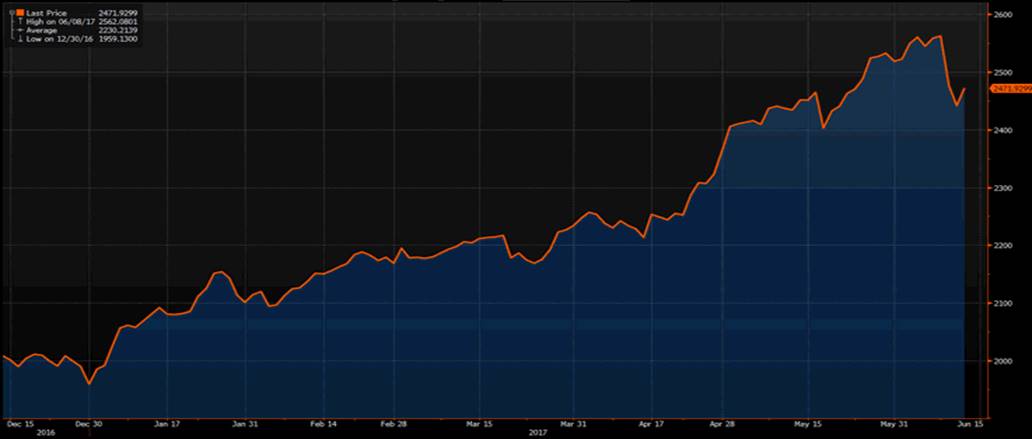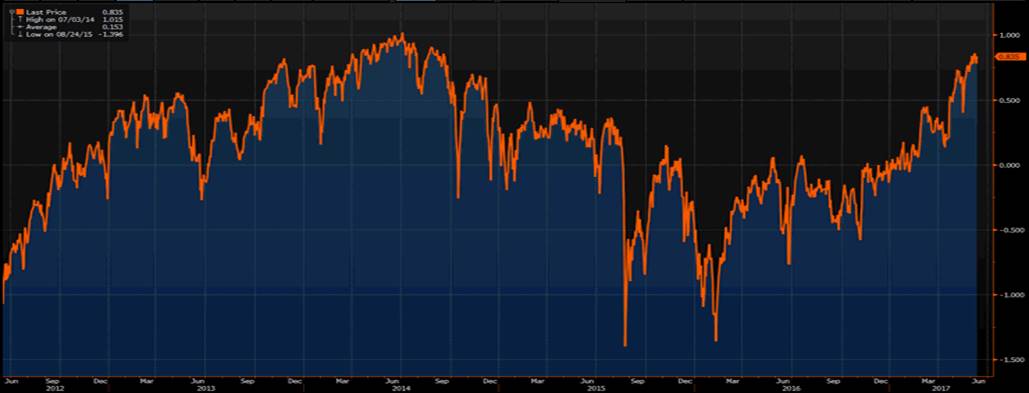The full attention of the market turns onto the US, but if there was any angst of owning risk assets ahead of the plethora of upcoming event risks then it’s hard to see where the market has been troubled.
US, European and emerging market equities have found buyers and the notorious FANG basket or FAAMG, or whatever abbreviation of what are effectively market leaders has also rallied. My own basket of Facebook (NASDAQ:FB), Amazon (NASDAQ:AMZN), Netflix (NASDAQ:NFLX), Alphabet (NASDAQ:GOOGL), Apple (NASDAQ:AAPL) and Microsoft (NASDAQ:MSFT) (see Bloomberg chart below) has gained 1.2%, and this will still get focus in the session ahead, but specifically, a move in Apple through Friday’s close of $148.98 would provide more conviction that tech does not roll over and head south from here.
The S&P 500 and Dow Jones have broken out to new all-time highs, with reasonable breadth (77% of S&P 500 companies closed higher on the day), with volumes very much in-line with the 30-day average.

As a lead in for Australia, we can see that while tech has found buyers (which won’t wholly affect us), however, financials (+0.44%) and materials (+1.3%) have also performed well and that should support the ASX 200 on open.
In FX markets the USD index has dropped a touch, with the CAD continuing to be the strong performer, with USD/CAD hitting a low of $1.3211. Keep an eye on the daily chart of USD/CAD as the pair is finding buyers at the April pivot low and may retrace some lost ground here. Saying that, a close below this level and we should see an extension of this bearish trend into $1.3000. USD/JPY is the natural proxy of all things Federal Reserve and that pair has traded in a tight range of ¥110.27 to ¥109.83 on the session.
This tight range in USD/JPY is thematic of such limited moves in US fixed income, across the yield curve and again fixed income will be the purest read of the Fed meeting tonight and I would be paying most close attention to the US five-year treasury over the coming 24 hours given its sensitive to the economic projections and potential views of longer term around the fed funds rate.
The ‘real’ (or inflation adjusted) five-year rate will also be keenly watched, as this seems to be having a strong bearing on overall financial conditions and a sharp drop in real yields post FOMC (at 04:00 aest) and Janet Yellen’s testimony shortly after, will likely be a strong catalyst for gold, emerging market assets and the FANG baskets.

Of course, if we see real yields pushing higher it would represent a tightening of financial conditions, which is kind of what you would expect when a central bank raises rates. That could weigh on the S&P 500.
That being said, the market isn’t even really interested in the fact the Fed will hike the fed funds rate tonight - it's fully baked in. It’s really all about the interest rate curve into 2018, 2019 and even 2020. So it’s an exercise in understanding what priced in, or what could be said is not priced in. If we take the fed fund future (a tradeable interest rate instrument) we can see the yield here sitting a 1.555% on the January 2019 contract and 1.745% January 2020. This effectively details 64.5 basis points (or 2.5) and 83.5bp (3.3) of hikes priced in through to the end of 2018 and end of 2019.
Contrast this to the Fed’s so-called ‘dot plot’ tonight and there will be much focus on the divergence here. Rates traders will also be following narrative around potential normalisation of the Fed’s $4.46 billion balance most intently, where I feel this will start of fall around the October meeting.
I also think it the market will be fairly sensitive to the US May CPI figures released at 22:30 aest, with the market expecting core inflation at 1.9% annualised. Naturally, this will be superseded by the Fed meeting, but the Fed will be not like the dynamic of extremely accommodative financial conditions, amid falling inflation and subdued inflation expectations.
Aggregating all the overnight news and we are expecting the market to build on yesterday’s gains, specifically in the ASX 200. There are some headwinds however, with spot iron ore down 2.8%, while in the Dalian futures exchange iron ore, steel and coking coal futures were sold off 2.3%, 0.9% and 0.7% respectively.
US crude has traded in a range of $46.57 to $45.56 and was providing us some hope that energy stocks were going to find buyers on open, but we have seen a fairly bearish read on the weekly API oil inventory report (out earlier at 06:30 aest), with US crude and gasoline inventories increasing 2.8 million and 1.8 million barrels respectively.
Consider the analysts were looking for a 2.3 million barrels drawdown in crude inventories in the official Department of Energy report (out at 00:30 aest) and the market is now somewhat positioned for a bearish surprise when the DoE release its statistics. Recall, last week’s API report was actually a terrible pre-cursor so I wouldn’t read too much into it.
How the market trades for the rest of the day is obviously not yet known, but had you told me at the start of the day yesterday that the financial sector was going to put 49 points into the index and REITS 11 points, I wouldn’t have believed you. Either way, we will be looking for further flows into this move, while healthcare has been a sector I’ve been bullish on and the ASX 200 healthcare sector is a mere 1.2% from a new all-time high. This is where we are seeing the outperformance and the momentum trade working well in Australia.
